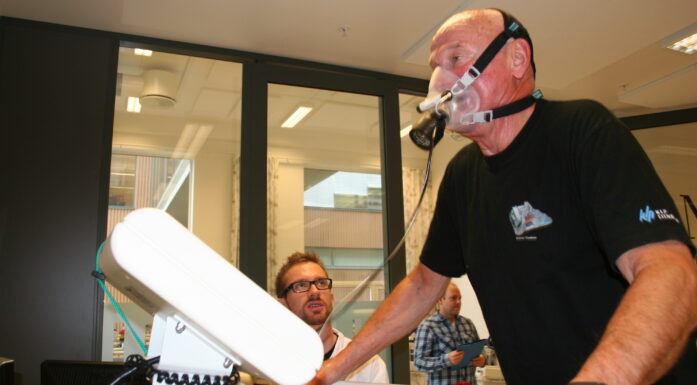Genes affect your blood pressure from early childhood
Certain genes associated with hypertension affect blood pressure from early in life, and they increase the risk of cardiovascular disease as you get older. But you can do something about it.
“We are talking about really small differences, so small that they may fall within what is considered normal blood pressure. The problem is that they tend to last your whole life,” says Karsten Øvretveit, a PhD candidate at NTNU’s Department of Public Health and Nursing. Øvretveit is one of the researchers behind a study that has looked at the relationship between gene variants and blood pressure in the population.
The researchers found that high blood pressure occurs in all age groups and that it is related to hereditary factors.
“We found that genetic factors affect blood pressure from the first years of childhood and throughout your entire life,” says Øvretveit.
- You might also like: Norwegian family’s medical mystery solved
Genetic data from large population studies
High blood pressure is the main cause of heart attacks and strokes, and cardiovascular disease is the second most common cause of death in Norway, accounting for 23 per cent of all deaths in 2022.
The direct medical cause of high blood pressure is unknown in many cases, but research shows that our genes play a significant role.
“Lifestyle diseases are often caused by a combination of heredity and environment. Diseases are often the result of not only one, but very many genetic variants,” says Øvretveit.
In order to find out how much a person is at risk of high blood pressure, researchers have used genetic data from large population studies. This has helped them develop a genetic risk score, which indicates how much your exact genetic makeup puts you at risk.
- You might also like: The answer to the blood pressure mystery may lie in our genes
Developing genetic risk scores
Put very simply, a certain value is placed on each gene variant, which reflects the extent to which it can affect blood pressure. The variants are then “weighted”, i.e. some genes weigh more heavily than others, and the genetic risk score is then the sum of the genetic effects.
“This is how people who are particularly at risk can be identified, and measures can be taken at an early stage before the condition is expressed.
By keeping their blood pressure low, people with a high genetic risk score can have a lower risk of disease than people diagnosed with high blood pressure who we consider genetically protected.
By keeping their blood pressure at a low level, people with a high genetic risk score can achieve a lower risk of disease than people diagnosed with high blood pressure who we consider genetically protected,” says Øvretveit.
To study the significance of the genetic risk, the researchers have used health data from participants in the HUNT Study from Trøndelag and from the British ‘Children of the 90s’ study. The latter includes health data from nearly 14,000 children from the time they were born until they were in their twenties.
What is HUNT?
The Health Survey in Trøndelag (HUNT) is a large, Norwegian population-based health survey that includes health information and biological material from the inhabitants of Trøndelag. Since the first collection round in 1984, 250,000 people from Trondheim have participated. A fifth survey, HUNT5, is planned for 2027.
By comparing the blood pressure of the children who had the highest genetic risk with the children who were lowest on the scale, the researchers were able to see how the average blood pressure in the first group was higher from as early as the age of three. The difference lasted throughout their childhood and became more pronounced in adulthood.
Difference increases with age
“Although the differences in blood pressure are not very large, the time component is important. If your blood pressure is slightly elevated over many years, it will affect how prone you are to cardiovascular disease and kidney disease,” says Øvretveit.
When the researchers compared the risk scores and health data of the HUNT Study participants, they saw that the differences in blood pressure between the participants with the highest and those with the lowest risk persisted throughout their whole lives.
“We have been able to follow the same people from when they were around 37 until they were approximately 70 years old. We found that the differences persisted and resulted in various disease risks, where the differences in disease were quite large.”
The researchers also found more positive results: if measures are taken, such as lifestyle changes and medications, the risk of disease can be significantly reduced.
“By keeping their blood pressure low level, people with a high genetic risk score can have a lower risk of disease than people diagnosed with high blood pressure who we consider genetically protected. It seems that controlling your blood pressure matters more than genetics,” says Øvretveit.
Large population studies provide good data
As a basis for the study, Øvretveit and colleagues have used findings from the largest genetic study on blood pressure currently available, which includes data from over a million people. Øvretveit believes the study shows the possibilities that lie in genetic data from large population studies.
“I don’t think you should start measuring blood pressure in every single child, but the type of data we have used in this study can be used in the future not only to prevent disease, but also to address the risk factors associated with a disease,” he said.
Is it a problem that Europeans are overrepresented in population studies?
“Yes, it is, but we are now actively working on developing genetic risk scores that are adapted to other populations, and that can be used across many different populations,” Øvretveit said.
To date, the researchers have identified around 1500 gene variants that have a clear connection with blood pressure, but the biological effect that many of these genes have on blood pressure is not known. In order to find a reliable method, the researchers had to identify high-risk combinations of gene variants and combinations that posed a lower risk through a process of trial and error.
“A common method for creating a risk score for genetic disease is to include only those gene variants that are known to have a strong connection with the disease,” says Øvretveit.
But there are other methods such as including gene variants that produce effects we are more uncertain about. As a result, we get a lot more data in the calculation.
“Complex blood pressure traits may be affected by far more gene variants than we have identified so far. The methods we have developed allow this to be taken into account, but we also have to keep in mind that the individual effects of these variants are small,” says Øvretveit.
The method that gave the most accurate risk score included over a million gene variants.
“But there are far more that have a known connection with high blood pressure,” says Øvretveit.
What is blood pressure?
High blood pressure is called hypertension. When your doctor measures your blood pressure, they measure the force of blood pressing against the walls of your blood vessels. Blood pressure is not constant, it can vary significantly according to the time of day and the situation you are in. When the average pressure is elevated, it is called hypertension.
Doctors use two numbers when measuring blood pressure, such as 140 over 90. The first number is called systolic pressure, which is the pressure when your heart pushes blood out. This pressure indicates when the heart beats, i.e. the pressure wave that can be felt as a pulse in the blood vessels.
The second number is called diastolic pressure, and this is the pressure in the blood vessels when your heart rests between beats.
If the systolic pressure is over 140 or the diastolic pressure is over 90, you have high blood pressure. A diagnosis of high blood pressure requires your blood pressure to be elevated over time, which is why doctors usually measure it several times. If you have kidney disease, an average blood pressure above 130 over 80 is considered unfavourable.
Blood pressure drives blood around the body, and if the pressure is too high over lengthy periods of time, it can damage blood vessels. This can lead to diseases such as heart attacks, strokes, eye fundus changes and kidney damage.
Source: Helsenorge.no
Reference: Karsten Øvretveit, Emma M L Ingeström, Michail Spitieris, Vinicius Tragante, Kaitlin H Wade, Laurent F Thomas, Brooke N Wolford, Ulrik Wisløff, Daniel F Gudbjartsson, Hilma Holm, Kari Stefansson, Ben M Brumpton, Kristian Hveem: Polygenic risk scores associated with blood pressure traits across the lifespan, European Journal of Preventive Cardiology
https://doi.org/10.1093/eurjpc/zwad365






